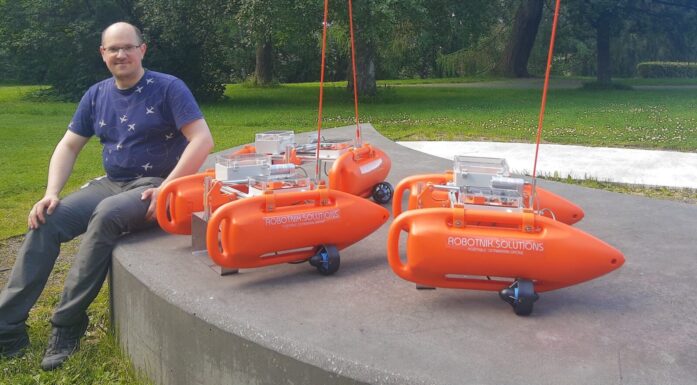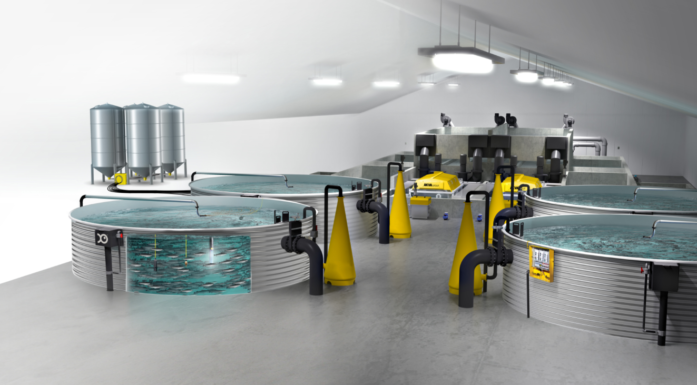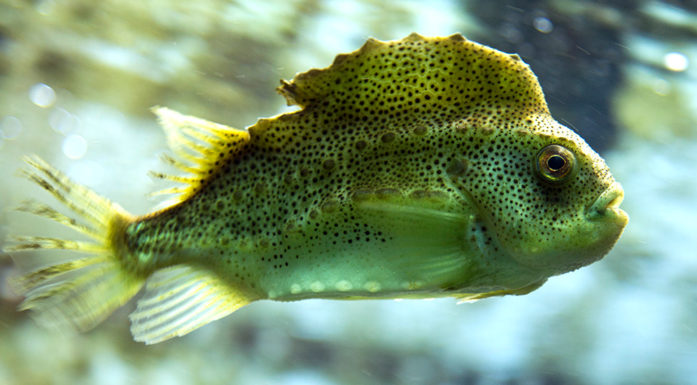Tourism, aquaculture and offshore accidents with Blueye
Blueye is an underwater drone that got its start at NTNU. The drone can be used for serious purposes – such as when it mapped damage to the Norwegian frigate Helge Ingstad – or for entertainment, such as showing cruise passengers the underwater landscape.
Blueye is an underwater drone with lights and a camera that enables the exploration and filming of ocean life without needing to dive into the depths. The drone is controlled by a smartphone or tablet via a cable and can descend to 150 metres.
After extensive testing and development during the pilot phase, the underwater drone is now on the market.
The Norwegian Armed Forces have even used the drone to map the damage to the frigate Helge Ingstad, which crashed and sank on its return from NATO’s major “Trident Juncture” exercises before Christmas.
Using the Blueye drone, the Armed Forces piloting the operations from the surface could see and film the damage inside and out.
The weapons that were on board had to be removed before raising the frigate. The underwater drone helped provide real-time information, which increased the safety and control of the underwater operations.
Designed for the public
The idea arose among dedicated underwater enthusiasts to create an underwater drone that would be available to everyone.
The ocean, which covers about 70 per cent of the Earth’s surface, is the source of vital resources such as food, energy, medicines – and two-thirds of the oxygen we breathe. But there’s still a lot we don’t know about the ocean.
“The underwater drone has hit the bullseye for the aquaculture industry.”
The team behind the entrepreneurial company Blueye Robotics believes the right tools could lessen these knowledge gaps. This is why the company wants to make it easier for the public to experience and learn about what is hidden beneath the ocean surface.
Many applications
The underwater drone, which was aimed at the consumer market from the get-go, has also hit the bullseye for the aquaculture industry. Many of the 700 pre-ordered drones will be used to check on fish farming cages and how the salmon swimming inside them are doing.
Searches related to accidents at sea are another useful drone application. An underwater drone is a simple tool to quickly search for things or people, and the Norwegian Society for Sea Rescue has entered into an agreement with Blueye to try out the underwater drones.
Tourism and the adventure industry offer further relevant uses. The Hurtigruten coastal cruise company has already ordered several Blueye drones to offer its passengers underwater experiences and discoveries.
This type of drone will also make it easier to check for damage on things like boats, piers and lobster pots without people having to dive to do it.
And investigating the seabed in a given area for suspected pollution, for example, will be far cheaper to do by underwater drone.
“In addition, we’re hoping that underwater drones can help provide more information about the climate and the state of the oceans more easily and cheaply than before,” says CEO Erik Dyrkoren, one of the founders of Blueye Robotics.
Here Blueye is being used to film an old plane wreck in the Trondheim Fjord:
Tested on the Great Barrier Reef and in the Arctic
The company was started in 2015 and currently has more than 20 employees.
“It’s grown really fast. We tested our first prototype in the ocean only ten weeks after we started working on it,” says Dyrkoren.
One of the cofounders, Christine Spiten, was participating on a voyage across the Atlantic from Senegal to Brazil to investigate marine plastic pollution. She took the very first prototype of Blueye along on the expedition.
In 2018, Spiten was named one of the 30 most influential young technologists in Europe on American magazine Forbes’ annual 30 Under 30 Europe list.
The underwater drone has also been put to the test mapping the changes in the corals on the Great Barrier Reef in Australia and on research expeditions in the Arctic.
More than a technology company
Now, many versions later, the underwater drone is ready for use. The company has focused on developing good technology at an affordable price and creating a product that is easy to handle both in terms of technology and weight.
“The underwater drone has also been put to the test mapping the changes in the corals on the Great Barrier Reef in Australia and on research expeditions in the Arctic.”
“A lot of pieces have to fall into place, for instance in relation to hardware,” says Dyrkoren. The parts are produced in different countries around the world, and the drone is assembled in Poland.”
“But we’re much more than just a technology company. We work hard to create content and a visually pleasing product. That’s why we’ve been working closely with Eggs Design right from the start,” says Dyrkoren.
Their efforts have led to numerous YouTube stories from the drone tests – everything from test runs in Trondheim Fjord to the Arctic and Great Barrier Reef expeditions.
People can also follow drone developments and trials via the company’s frequent Facebook updates.
Recently, the Blueye team sent the drone down under the black ice of Jonsvatnet lake in Trondheim:
Enthusiasm as engine of success
Employee enthusiasm has been a powerful engine in the company’s success so far.
“The hardest part actually lies ahead for us. We need to figure out how to transition from a start-up company with all the enthusiasm and effort that entails, to becoming a business that is starting to market globally. And at the same time we want to develop a culture where we take care of people’s engagement. Google is an example of a company that has managed to do this. The company is considered one of the world’s best companies to work for and attracts talent,” says Dyrkoren.
The Blueye drone has hit the domestic market well. The company also intends to go international but is taking one step at a time.
“We’ve been sniffing out China, but you have to be bigger to get established there. But it’s a market that we’re thinking about over time,” Dyrkoren says.
NTNU spin-off
“Blueye is a good example of what academic environments at NTNU can achieve by joining forces and using each other’s expertise and skills,” says Dyrkoren.
He notes that having NTNU’s Centre for Autonomous Marine Operations and Systems (AMOS) on the team has been particularly important. They are world-class leaders in underwater robotics and have experts on navigation systems for this type of craft.
In January, the Blueye Pioneer was tested in high water temperatures in Mauritius. Here the coral reefs show clear growths due to increased water temperature:




